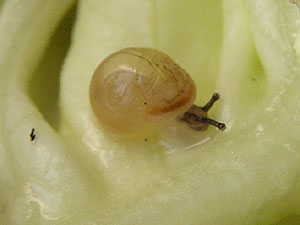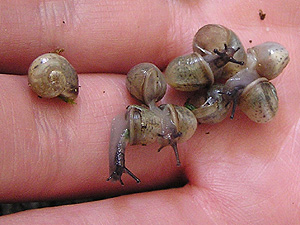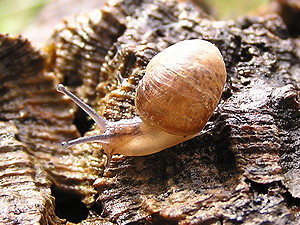
This freshly hatched Roman snail is only one day old. It still
has a soft shell, which must be hardened with lime. [RN]
 This freshly hatched Roman snail is only one day old. It still has a soft shell, which must be hardened with lime. [RN] |
Snails, like other molluscs, generally develop past a larval stage. The fertilised egg cell by continuous cell cleavages an embryo form, that gradually develops into a larva.
It is not only sea snails, but also terrestrial snails that develop past such a larval stage. A Roman snail larva also does not resemble the adult; it even has got larval organs not present in an adult snail. Other than sea snail larvae that are distributed by floating like plankton with the water currents, a Roman snail's larva never leaves its egg. All of the snail's embryonic and larval development takes place inside the egg.
The development is concluded by a metamorphosis, during which the larva changes its shape and develops into a juvenile snail. During the metamorphosis the larval organs are reduced and the juvenile snail's final organs form; they enable the snail to live on dry land – their function is indispensable for the snail able to hatch. One organ system that comes into existence is the respiratory system that is not yet present in the organism of the larva.
The young snail hatching after 25 days from a Roman snail's egg externally almost looks like an adult snail. The is the complete albeit small body with head and foot, four tentacles, as well as a translucent shell, though whose transparent walls the heart can be seen beating. Only the genital organs are not yet developed. The snail's hermaphroditic gland will have to mature, so it is able to produce egg and sperm cells by the third life year of the young snail.
The development from the fertilised egg cell to the juvenile snail hatching takes about 25 to 26 days among Roman snails. It is, though, very susceptible to external factors, such as temperature and humidity.
 The number of whorls in their shells shows that these juvenile snails are a already some weeks old. [RN] |
The first 8 to 10 days after hatching the juvenile snails stay in the earth
hole that serves as their hatchery. In this time they eat the remains of their
eggs and the albumen within. They so take in the first nutrients and the first
lime to strengthen their soft shell. Especially when the development in one
batch of eggs takes a different amount of time, the juveniles hatched first not
only eat the remains of their own eggs, but also of their siblings' eggs and
sometimes even their dead siblings. It may even happen they eat their younger
and weaker siblings, which means cannibalism in the hatchery. But this sometimes
occurring cannibalism also means a way of selection: Research has revealed, that
juvenile snails that had fed on their weaker siblings, were considerably bigger
when leaving the hatchery and thus had a definitely better position to start
from.
![]() :
Kothbauer,
H. (1972)
:
Kothbauer,
H. (1972)
From their earth hole the juvenile snails have to free themselves on their own. They eat and dig through the earth cover until they reach the surface.
On the spot the young snails try to climb plant stems as soon as possible to evade being hunted on the ground. For ants and other predatory insect the young defenceless snails are easy prey.



 Juvenile Roman snails at the age of few weeks (first three pictures) and at the age of five months. At this age, the young snail already clearly resembles an adult snail and will be able to survive its first winter. [RN] |
The young snails start looking for food and to grow. In the months until their first winter, depending on food supply, the may reach 10 mm in size and grow three more whorls on their shell. Maturity they generally will only reach after their second winter. Until then their shell will have grown to 5 whorls and 40 mm in diameter. Because of the large amount of lime inserted into its walls, it will almost be indestructible.
It will be a long way to go. In nature, only about 5% of young snails manage to survive until maturity.
![]() Reproduction and Development of the Roman Snail (Illustration).
Reproduction and Development of the Roman Snail (Illustration).